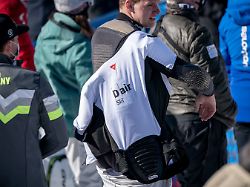Are there a risk of more injuries?
Mandatory airbags are making the ski scene crazy
December 26, 2023, 6:55 p.m
Alpine skiers plunge down the slopes at great risk, including falls and serious injuries. The world association is therefore introducing a requirement to wear airbags. But many people don’t agree with that. On the contrary, most people think nothing of it.
Ski racer Broderick Thompson stumbles at high speed, falls, is catapulted into the air and hits the hard slope from a height of several meters. Rescuers fly the Canadian to the hospital, where doctors briefly put him in an artificial coma. The Austrian head coach Marko Pfeifer said as an eyewitness that the accident was “one of the worst things I have ever seen”. It’s been almost a month since Thompson’s training crash at the end of November in Beaver Creek, and the athlete is feeling better again. He was not wearing an airbag on the day of the accident.
This will no longer happen next year. For the 2024/25 season, the world association FIS will make wearing a special airbag under the ski suit mandatory for women and men in super-G and downhill. When asked to justify the new rule, an FIS spokeswoman said that airbags had “proven to be a valuable measure to increase the safety of athletes in speed races.” Men’s race director Markus Waldner said Thompson’s crash would have been less severe with an airbag.
So is everyone happy about the FIS safety regulations from the coming season? Not at all! Many drivers and supervisors are uncertain and incomprehensible about the world association’s decision. Many people find the special vest with the inflatable air chambers impractical when racing. Some people doubt that the airbag really protects them. Some fear that the high-tech equipment actually poses a danger.
“Typical F sharp nonsense”
“This is another typical FIS nonsense!”, Wolfgang Maier, the sports director in the German Ski Association (DSV), recently complained and spoke of “actionism”. Similar to the sudden ban on fluorine waxes, which has caused great uncertainty in the World Cup since this winter, the airbag requirement could end in chaos.
One person who knows the topic is Karl-Heinz Waibel, the national coach for science and technology at the DSV. Until recently, he was part of a FIS expert group in which he discussed the airbag together with other officials and ex-athletes such as Pernilla Wiberg and Marco Büchel. The group spoke out against mandatory airbags. “There is no need for an airbag against serious back injuries; back protectors have been doing a good job since the 1990s,” explained Waibel. In his opinion, the airbag could perhaps protect against bruises. “But no ski racer complains about upper body bruises.”
Waibel emphasized that he was not fundamentally against the airbag. But research and development is much more important when it comes to preventing serious knee injuries, the biggest concern in skiing. Waibel called the airbag a “trivial matter.” The FIS ignored the experts’ assessment – and recently quietly and secretly dissolved the group.
Dreßen had both shoulders dislocated
So is the airbag almost useless? Or even more serious: is it even dangerous? In recent years, some athletes – such as Austria’s Olympic champion Matthias Mayer and the German downhill skier Manuel Schmid – suffered noticeable vertebral injuries in falls in which the airbag was deployed. According to dpa information, the manufacturers deny blame for such injuries in official letters to the FIS.
But the mistrust grew. The German veteran Romed Baumann, for example, drove with an airbag for seven years, but after his teammate Schmid was injured in the summer of 2021, he put it aside again. “I didn’t have a good feeling anymore,” said Baumann. In the German alpine men’s team, only the youngsters Luis Vogt and Jacob as well as Thomas Dreßen currently use the airbag – it can be assumed that the ex-Kitzbühel winner Dreßen both suffered a fall in a race at the beginning of 2020 due to the force of the airbag inflating at lightning speed Shoulders were dislocated.
Even top stars like the Norwegian Aleksander Aamodt Kilde or Dominik Paris from South Tyrol don’t put on an airbag when they take part in the downhill run on Thursday and the Super-G on Friday (11:30 a.m. each) in Bormio on one of the iciest, most difficult and most dangerous slopes in the world Compete in the World Cup calendar.
But everyone has to come to terms for the new season. The concerns and sometimes legal questions that, according to dpa information, nations such as Germany, Austria and Switzerland submitted to the FIS will hardly change this. For example, who is liable if athletes – against their will – wear an airbag during a race and it malfunctions? What happens if an airbag deploys incorrectly and an athlete falls? As can be heard, the FIS has not provided any satisfactory answers.
